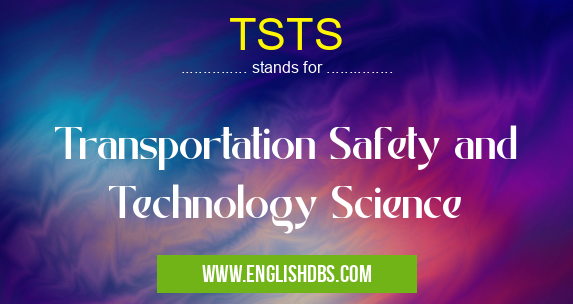What does TSTS mean in ACADEMIC & SCIENCE
TSTS stands for Transportation Safety and Technology Science. It is a branch of science that focuses on the development and application of technology to improve the safety of transportation systems. This includes research on new materials, designs, and systems to prevent accidents and reduce the severity of injuries in the event of a crash.

TSTS meaning in Academic & Science in Academic & Science
TSTS mostly used in an acronym Academic & Science in Category Academic & Science that means Transportation Safety and Technology Science
Shorthand: TSTS,
Full Form: Transportation Safety and Technology Science
For more information of "Transportation Safety and Technology Science", see the section below.
What is TSTS?
TSTS is a multidisciplinary field that draws on a variety of disciplines, including engineering, computer science, human factors, and public health. TSTS researchers work to understand the causes of transportation accidents and develop new ways to prevent them. They also work to develop new technologies to improve the safety of transportation systems, such as advanced driver assistance systems, crash avoidance systems, and electronic stability control systems.
Importance of TSTS
TSTS is an important field of research because transportation accidents are a major cause of death and injury worldwide. In the United States, for example, there were over 6.7 million car crashes in 2020, resulting in over 39,000 deaths and over 4.5 million injuries. TSTS research has the potential to save lives and prevent injuries by developing new technologies and strategies to make transportation systems safer.
Applications of TSTS
TSTS research has a wide range of applications in the transportation sector. Some of the most common applications include:
- Developing new materials and designs for vehicles to make them more crashworthy.
- Developing new systems to prevent accidents, such as advanced driver assistance systems and crash avoidance systems.
- Developing new technologies to improve the safety of transportation infrastructure, such as electronic stability control systems and rumble strips.
- Conducting research on human factors to understand the role of human error in transportation accidents.
- Developing new public health policies and programs to reduce the number of transportation accidents and injuries.
Essential Questions and Answers on Transportation Safety and Technology Science in "SCIENCE»SCIENCE"
What is Transportation Safety and Technology Science (TSTS)?
TSTS is a multidisciplinary field that focuses on the design, implementation, and evaluation of technologies and systems to improve the safety and efficiency of transportation. It encompasses various areas such as vehicle engineering, traffic management, human factors, and data analytics.
What are the key goals of TSTS?
TSTS aims to reduce traffic fatalities and injuries, mitigate congestion, enhance mobility, and improve the overall efficiency of transportation systems. It also seeks to develop and implement technologies that promote sustainability and reduce environmental impact.
How does TSTS contribute to society?
TSTS plays a vital role in creating safer roads, reducing travel times, and improving access to transportation. By leveraging advanced technologies and data-driven approaches, it helps optimize transportation infrastructure, enhance vehicle safety features, and promote responsible driving behaviors. These advancements contribute to economic growth, social well-being, and environmental sustainability.
What types of technologies are used in TSTS?
TSTS utilizes a wide range of technologies, including:
- Vehicle sensors and communication systems (e.g., radar, lidar, cameras)
- Traffic management systems (e.g., traffic lights, congestion monitoring)
- Data analytics and predictive modeling
- Artificial intelligence and machine learning
- Human-centered design and user interfaces
How can I pursue a career in TSTS?
To embark on a career in TSTS, you typically need a bachelor's or master's degree in a relevant field such as engineering, transportation science, computer science, or data science. Specialized courses in TSTS principles and technologies are also beneficial. Industry experience and certifications can further enhance your credentials.
Final Words: TSTS is a rapidly growing field of research that has the potential to make a significant contribution to improving the safety of transportation systems. By developing new technologies and strategies to prevent accidents and reduce the severity of injuries, TSTS researchers are helping to save lives and prevent injuries.
